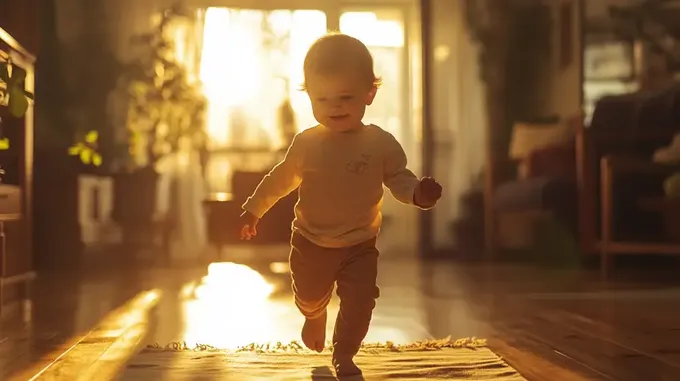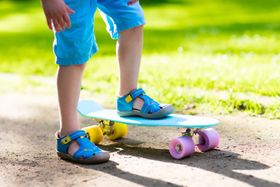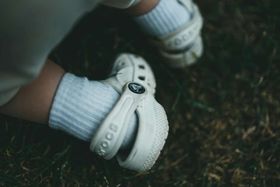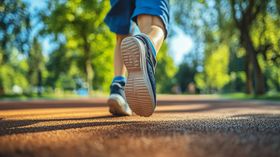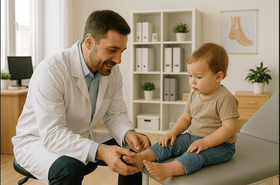Understanding the Waddling Gait in Children: Parent’s Guide
Explore the hidden causes behind toddlers' unusual walking patterns and how parents can help their little ones walk with confidence
Updated December 5, 2024

Those first wobbly steps are magical moments in every parent's journey. But if your little one's walk reminds you more of a penguin waddle than a straight-line stroll, you might be wondering what's going on.
While a waddling gait in children can be perfectly normal during early walking, it helps to understand when it might need attention. In this guide, we'll explore possible causes, when to seek professional advice, and how to support your child's walking development.
» Is your toddler waddling? Choose shoes designed to support a healthy gait
What Is Waddling Gait in Children?
When toddlers learn to walk, some develop a distinctive side-to-side movement pattern. This waddling gait is when your child takes wider steps, with their feet pointing outward and their hips swaying as they move.
While this might look abnormal, it's often part of their walking development as they learn to balance and stay steady.
When Should You Be Concerned?
Every toddler's journey to walking is unique, with plenty of wobbles along the way. But how do you know when that distinctive waddle needs professional attention?
Watch for these signs—especially after 18 months:
- Feet positioned unusually far apart when standing, like a little surfer catching waves
- Toes pointing outward, walking like a tiny penguin
- Hips swaying noticeably from side to side during walking
- Feet dragging or shuffling rather than lifting cleanly
- Frequent stumbling, particularly during quick movements or direction changes
Trust your parental instincts—if something about your child's walk doesn't feel quite right or seems uncomfortable, it's always better to check with your paediatrician.
» Learn what's normal (and what's not) in your toddler's walking journey
Understanding Possible Medical Causes
While many toddlers naturally waddle as they master walking, sometimes an underlying reason needs attention. Here's what medical professionals typically look for:
- Developmental Hip Dysplasia (DDH): When your child's hip joint doesn't form properly, causing the thigh bone to slip partially or fully out of its socket
- Perthes Disease: A temporary loss of blood flow to the hip that can cause the thigh bone head to flatten
- Slipped Capital Femoral Epiphysis (SCFE): When the top of the thigh bone separates from the hip joint growth plate
- Cerebral Palsy: Affects how your child moves and maintains balance
- Muscular Dystrophy: Makes leg muscles gradually weaker, changing how your child walks
- Spinal Muscular Atrophy (SMA): Affects nerves that control muscle movement, leading to muscle weakness
- Rickets: A vitamin D or calcium deficiency that can lead to weakened bones, causing irregular walking due to pain and altered hip joint growth
» Help your CP champion find their perfect kicks
How To Treat Waddling Gait in Kids
Spotting and supporting your child's walking style early helps ensure healthy development. Here are some treatment options to consider.
Supportive Footwear
Selecting the right shoes for your developing walker can significantly influence their comfort and walking confidence. Here's what to look for in supportive footwear:
- Flexible Soles: Choose shoes with lightweight, pliable soles that allow natural foot movement and help strengthen developing muscles
- Proper Arch Support: Ensure adequate arch support to promote better balance and proper foot positioning
- Non-Slip Protection: Look for shoes with grippy, non-slip soles to prevent accidents and boost confidence on various surfaces
- Growth Room: Select shoes with adequate toe space to accommodate growing feet and natural toe spreading during walking
Physical Therapy
Working with a physical therapist can help your child build strength and balance through gentle exercises. Your healthcare team can create a personalised plan to improve coordination and movement patterns.
Activities like swimming or gentle massage can also help. Remember to check with your healthcare provider first about what's best for your child's needs.
» Explore effective exercises to strengthen your child’s feet and ankles
Medications
Sometimes, your doctor might recommend medications to help with specific walking challenges. These can help manage discomfort, improve muscle function, or support children with special movement needs.
Surgery
In some cases, surgery might be needed to address structural concerns in the hips, knees, or ankles. This helps correct alignment and improve joint function when other treatments aren't enough.
» Give your busy explorer enough support for everyday play
Tools To Support Waddling Gait
Every child's journey to confident walking is unique; sometimes, they need extra tools to help them along the way. Your healthcare team might recommend specialised tools alongside supportive shoes:
- AFOs (Ankle Foot Orthoses): Custom-made braces that fit over feet and lower legs, helping with ankle stability and foot position.
- Braces: Support the hips, knees, or ankles, providing additional stability and reducing the strain on these joints.
- Walkers and Crutches: Provide additional support and stability while walking, especially for children with weak or impaired legs.
- Gait Trainers: Wheeled devices that help your child build confidence while moving independently.
- Custom Orthotics: From foot-supporting insoles to hip and knee supports that guide proper alignment. These personalised solutions fit discreetly into your child's daily routine while providing crucial stability and comfort.
The goal is to provide just enough help to build strength and confidence while encouraging natural movement development.
» Explore our selection of the best kids' shoes for orthotics
Building Confident Steps Together
Every child's walking journey is uniquely their own, shaped by dedicated support and thoughtful choices. By working closely with your healthcare team and including their recommendations in your daily routine, you create a supportive environment fostering growth and development.
» Ready for the next step? Find the perfect shoes to support a waddling gait
Disclaimer: First Walkers' information is intended for educational and informational purposes related to toddler footwear and feet. We encourage you to consider individual circumstances and consult qualified orthopaedists about specific conditions.

